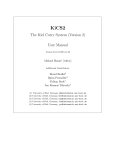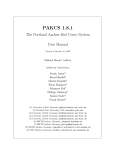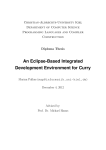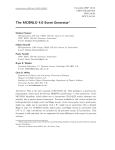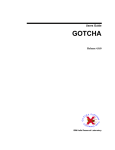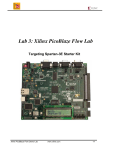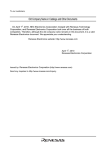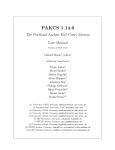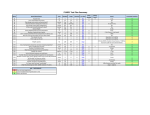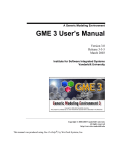Download here in pdf - UW Departments Web Server
Transcript
CCL
The Computation and Control Language
User’s Manual
Eric Klavins
Electrical Engineering Department
University of Washington
Seattle, WA 98195
klavins at washington.edu
1
1
Introduction
This manual describes the CCL language and associated tools. To get started
with CCL, make sure that you have CCL built and installed and that the
CCL ROOT and LD LIBRARY PATH environment variables are set correctly (see
the CCL web page for details).
Here is how to say “hello world” in CCL. First make your own directory
for your examples:
mkdir code
cd code
In your new directory, create a file called hello.ccl with the following text
in it:
include standard.ccl
program main() := {
str := "Hello world!";
true : {
print ( str, "\n" ),
exit()
};
};
Run this program by executing
ccli hello.ccl
on the command line. Note that ccli is the name of the CCL interpreter.
The result of executing the above should be that “Hello world!” is printed
and then the program exits. If you get this to work, you have CCL properly
installed on your system.
Here’s how hello.ccl works. The first line includes some standard function definitions. In particular, we need the print function and the exit
function. The rest of the file declares a program, called main. The CCL
interpreter expects that a program called main will be defined. If it finds
one, it will execute it. If it does not, it will just quit. Within this particular
main program, there is one variable initializer (for the variable str) and one
guarded command. The initializer just sets the variable str to the string
“Hello world!”. The guarded command has a guard (true in this case) and a
2
set of commands. The commands print the value of str and then exit. The
CCL interpreter starts executes programs by first initializing variables and
then executing the guarded commands over and over again. This guarded
command exits the first time it is executed. Otherwise, it would print “Hello
world!” repeatedly until the interpreter is killed (with Cntl-C) (try removing
the exit line to see this behavior).
Note: Another way to evaulate expressions with ccli is to put them on
a line by themselves outside of a program definition. Thus, the above could
have been written:
include standard.ccl
str := "Hello world!";
print ( str, "\n" ),
and essentially the same output would be produced.
2
Values
CCL supports the following types
unit
boolean
integer
real (floating point) string
list
record
abstract functions (lambda) external functions
Lists are homogeneous: All elements of a given list must have the same type.
Here is an example program that demonstrates the different types:
// booleans
true;
false;
// integers
1;
2;
// reals
1.0;
3.1415927E-2;
3
// strings
"abcdefg\n";
// lists
{ 1, 2, 3, 4 };
{ "a", "b", "c" };
{};
// records
[ x := 5, y := {}, z := "ccl is cool!" ];
// the identity function
lambda x . x;
// you can also write the above as
\ x . x;
More interesting expressions are covered in the next section. External
functions are covered later as well (print and exit are examples). Remember
that expressions appearing outside a program, terminated by a semicolon, are
evaluated as they are encountered by ccli and ccli prints each expression
and its valuation. Thus, the output of the above program will look a bit
repetitive. Also note that lines beginning with “//” are treated as comments.
Comments may also appear between “/*” and “*/” as in C.
The “unit” type is reserved for external functions that do not return
values. Don’t worry about it for now.
3
Expressions
Values are atomic expressions: not made up of other shorter expressions. In
this section we describe all the kinds of expressions you can build up from
shorter expressions in CCL.
3.1
Boolean Operations
Here is how you write and, not and or:
// simple boolean expressions
4
true & false;
! true;
true | false;
You can also compare integers and reals with <, >, <= and >= as in
( 1.0 < 2 ) | ( 3.0 >= -7 & 3.0 > 5.0 ) | false;
liberally mixing integers and reals and putting in parentheses.
Finally, you can test for equality and inequality of booleans, integers,
reals, strings and lists as in
1 = 2 | "a" != "b" | {1,2,3} = {4,5};
Test the equality of other types in not supported.
Warning: In ccli “=” means “equals” and testes for equality of its arguments. It does not perform variable assignment, as in some other languages.
Assignments are done with the “:=” operator.
3.2
Type Errors
The ccli interpreter will not let you enter expressions that use types incorrectly. For example, you can not compare integers and strings as in the
following:
1 = "one";
produces the error
Type error in ’example.ccl’ on line 1:
could not compare (= or !=) arguments
1 has type integer, while
"one" has type string
with information about what caused ccli to complain.
3.3
Arithmetic Operations
Integers and reals can be added, subtracted, multiplied, divided, mod-ed, and
raised to each other. If the arguments to the operation are both integers, the
result will be too. Otherwise, ccli with give you a real. Standard precedence
rules apply. You may use parentheses wherever you need to. Here are some
examples
5
!
// integer artihmetic
( 1 + 1 ) ^ 5 + 7 % 3;
// mixed
( 2.0 ^ 3 ) * ( 5.0 - 1.23E-3 ) - 1;
that evaluate to 33 and 38.990160 respectively.
3.4
String Operations
Besides comparing strings with = and != you can concatenate them with the
<> operator. The following yields the value true, for example
( "abc" <> "def" ) = "abcdef";
3.5
List Operations
Besides comparing lists with = and !=, you can add elements to lists and
concatenate them. Adding elements is done with the @ operator, and concatenating elements is done with the # operator.
For example, to insert the value 1 into the beginning of the list {2,3}
you do
1 @ { 2, 3 };
which yields the list {1,2,3}. To concatenate two lists, you write
{ 0, 1 } # { 2, 3 };
which yields {0,1,2,3}.
Note that you might find ccli printing out strange things like 0@(1@(2@{
})). No worries, this is just how ccli stores the expression {0,1,2}. The
two expressions evaluate to the same thing.
3.6
Record Operations
If you want to get the value of certain field in a record, you use the “.”
operator. For example,
[ x:= 0, y := 1 ].x;
6
evaluates to 0.
You may construct new records from old using the << operator. For
example,
[ x:= 0, y := 1 ] << [ x := -1 ]
evaluates to [ x := -1, y := 1 ]. More generally, the expression r << s
has all fields appearing in either r or s. The value associated with the a
particular field x in r << s is s.x if x exists in s, and otherwise it is r.x. If
r and s have a field name in common but do not assign that field a value of
the same type, a type error is produced.
3.7
Lambda Expressions, Applications and Currying
A lambda expression is a way to write a function without really giving it a
name. For example, here is a function that takes a number and negates it:
lambda x . -x;
and here is another that takes two elements are compares them:
lambda x . lambda y . x = y;
You can apply these functions to arguments by juxtaposing them as in:
( lambda x . -x ) 10;
which results in the value -10.
Note that lambda x . lambda y . x = y is a function that takes an
argument x and returns another lambda expression. Thus
( lambda x . lambda y . x = y ) 10;
returns another lambda expression as a value, namely
lambda y . 10 = y;
You can apply the whole expression to two numbers as in:
( lambda x . lambda y . x = y ) 10 11;
which evaluates to false.
The function lambda x . lambda y . x = y is polymorphic, meaning that it can be applied to any two arguments of the same type. In fact,
ccli considers its type to be
7
’a -> ’a -> boolean
where ’a is a variable type (i.e. it stands for any type). If you apply the
function to a string as in
( lambda x . lambda y . x = y ) "ccl";
you get a function of type
string -> bool
That is, putting a string as the first argument adds the constraint to the
ccli type checker that the second argument should also be a string. Thus,
( lambda x . lambda y . x = y ) "ccl" 5;
produces the type error
Type error in ’hello.ccl’ on line 23:
could not apply function to argument
( ( lambda x . ( lambda y . (x=y) ) ) "ccl" )
has type string -> boolean, while
5 has type integer
noting the problem. You also have to be careful about parentheses. For
example, the following produces an error
( lambda x . lambda y . x + y ) 10 - 11;
because it parses as
( ( lambda x . lambda y . x + y ) 10 ) - 11;
which makes no sense (you can’t subtract an integer from a function). Thus,
use
( lambda x . lambda y . x + y ) ( 10 - 11 ); // or
( lambda x . lambda y . x + y ) 10 ( - 11 );
depending on your intentions.
8
3.8
Conditionals
You can write if-then-else statements that evaluate to values as in
if 1 > 0 then 1 else 0 end;
which evaluates to 1. The “then” and “else” parts of the statement must
have the same types and the “if” part must be a boolean expression. Thus,
the following produce type errors:
if 1 then 1 else 0 end;
if 1 < 0 then 1 else "oops" end;
It is important to remember that, if-statements evaluate to values (kind of
like the a ? b : c syntax in C). So for example, the following is perfectly
legal:
"ccl is " <> ( if true
then "strange but beautiful"
else "just strange"
end );
which you can probably evaluate in your head.
3.9
Let Expressions
With a let-expression you can declare a local variable. For example, the
expression
let x := 10, y := x/2 in
x + y
end;
evaluates to 15. Once again, all expressions evaluate to a value, in this case
an integer. Thus you can write, for example,
1 + ( let x := 10, y := x/2 in
x + y
end );
which evaluates to 16.
9
4
Variables and Recursive Functions
In ccli, you can use variables in place of values. Assignments are done with
the := operator. For example, we could write
f := lambda x . lambda y . ( x + y ) / 2;
x := 10.0;
f x ( x + 1 );
which results in the value 10.5;
Special Variables Two variables are predefined by ccli. The first is
ARGC, an integer defined to be the number of arguments on the command
line to ccli (excluding options to ccli). The second, ARGV, is a list of the
arguments on the command line, interpreted as strings. For example, if you
call ccli like this:
ccli file.ccl 10 unix
then you get
ARGC = 4;
ARGV = { "ccli" "file.ccl" "10" "unix" };
Note: To convert the string "10" into the integer 10, use the standard.ccl
function atoi as in
include standard.ccl
n := atoi ( ARGV[2] );
Recursion Having variables allows us to write recursive functions. ccli
provides the keyword fun for declaring recursive functions. Here’s the hoary
chestnut
fun fact n .
if n <= 0
then 1
else n * fact (n-1)
end;
fact 5;
10
that you see in every programming language manual. The code above sets the
variable fact to a representation of the factorial function and then applies
it to the value 5 to give 120.
Note, you can’t do
fact := lambda n .
if n <= 0
then 1
else n * fact (n-1)
end;
because ccli will complain that fact is an unbound variable (which it is in
this case: the right hand side of an assignment is always evaluated before the
left hand side unless you use the fun keyword).
5
External Functions and Parentheses
ccli provides some externally defined functions – and you can define your
own (as described later). These functions are not lambda expressions and
thus they use a different syntax. For example, the file $CCL ROOT/lib/math.ccl
defines some standard math functions, like cosine and sine. To use them, you
write, for example,
include math.ccl
x := sin ( 0.123 ) + 1;
but not
include math.ccl
x := ( sin 0.123 ) + 1;
which will produce a type error saying something like “you can’t apply the
value sin as though it were a lambda expression”. This is because sin is
declared as an external function type which means that to use it, you have
to put its arguments in parentheses. Another example is the print function,
which takes any number of arguments of any types and prints them:
include standard.ccl
x := 5;
y := { 1, 2 };
print ( "x = ", x, " and y = ", y, "\n" );
11
which does about what you would expect. Note that every expression in CCL
evaluates to a value of some type. Functions like print evaluate to the type
unit which ccli prints as a period ( as in “.” ). You aren’t supposed to use
the result of a print call, but it has to have a some sort of value (this is like
void in C). The math library and other libraries are described in Section 7.
External functions are declared with return types are argument types.
Types are denoted by type expressions (which you have seen in ccli’s type
error reporting. Type expressions are defined by the following grammar:
typeexpr ::= variable | atomic | listexpr | rec | func
variable ::= ’a | ’b | ...
atomic ::= unit | bool | int | real | string
listexpr ::= typeexpr list
rec ::= [ var := typeexpr, ... ]
func ::= typeexpr -> typeexpr
The special symbol ... may appear in record expressions and as the last
expression in the list of arguments to an external function. It means there
may be more arguments. For example,
external [ x := int, ... ] func ( ’a list, ... )
"library.so" "func";
declares the external function func. It has a record return type that has
the integer field x defined and may have other fields. It takes at least one
argument, a list of any type, and may take more arguments (of any type).
Including Libraries We have already seen the include statement. It is
a preprocessor directive (i.e. include is not a keyword, it is a directive to
the lexer part of ccli that reads in *.ccl files). It tells ccli to read in
the file noted in its argument before continuing with the preset file. ccli
provides several libraries in $CCL ROOT/lib, including standard input and
output, math functions, list operations, and simple graphics tools. These are
described in more detail in Section 7.
6
Programs
Programs are the heart of CCL. A program consists of two parts: A set of
initializers, and a set of guarded commands. Programs are intended to be
the guts of a while statement. As in
12
x := 1;
while true do
if x > 0 then x := x + 1 end;
print ( x );
end while
which is not a ccli program, by the way. In this psuedocode snippet, the
line x := 1 is an initializer and the if-statement is a guarded command. In
CCL you write
include standard.ccl
program main() := {
x := 1;
x > 0 : {
x := x + 1,
print ( x, "\n" )
};
};
which is a ccli program. If you make a file with the program above in it,
and then run ccli on the file, you will get
2
3
4
5
6
...
ad infinitum (press cntl-C to halt ccli). It starts by setting x to 1 and then
it continuously executes the guarded command over and over again.
The general syntax for a program declaration is
program p ( param_1, ..., param_n ) := {
statement_1
statement_2
...
statement_m
}
where the statements are either assignments of values to variables (and therefore initializers) or they are guarded commands. Guarded commands have
the form
13
boolexpr : {
command_1,
command_2,
...
command_k
}
which means, to ccli anyway, that while executing the program main, if
boolexpr is true, then execute all the commands in the body of the guarded
command. In each iteration of the program, ccli considers the guarded
commands in order and then, in those whose guards are true, executes the
assignments in order as well. A command is either an assignment or an
expression. In the latter case the expression is evaluated and its result is
thrown out (which is useful when the expression has side effects, as with the
external function print).
Initializer statements can also have the form:
needs x, y, z;
which tells ccli that the enclosing programs needs the values of x, y and z
to be initialized elsewhere. This will make more sense after you read Section
6.2, about program composition.
As we have noted, ccli looks for a program called main() to execute. So
if you want something to happen, you need a main program defined somewhere.
The parameters can be used to create a whole family of programs, one
for each set of values of the parameters. For example, you might write
include standard.ccl
program p ( x0, delta ) := {
x := x0;
x > 0 : {
x := x + delta,
print ( x, "\n" )
};
};
program main() := p ( 5.35, 0.01 );
which produces the output
14
5.36
5.37
5.38
...
ad infinitum. The program main should not have parameters.
6.1
Variable Memory
After a variable is assigned, ccli can remember its previous value. For a
variable is x, the expression ’x (read prev x) refers to its previous value. Note
that ’’x is the same as ’x. That is, ccli only remembers one step back.
This is useful in programs where you might need to know the difference
between the current value of a variable and its value the last time through.
For example, here is one way to write the Fibonacci sequence:
include standard.ccl
program main() := {
x := 1;
true : {
print ( { ’x, x }, "\n" ),
x := x + ’x
};
};
Executing fib(1) produces
{ 1, 1 }
{ 1, 2 }
{ 2, 3 }
{ 3, 5 }
{ 5, 8 }
{ 8, 13 }
{ 13, 21 }
{ 21, 34 }
...
ad infinitum.
Warning: Assignments such as a[i] := x or r.a = x are designed to be
as efficient as possible and for technical reasons do not preserve the variable
memory structure. Thus,
15
!
a := {};
a := { 1, 2, 3 };
a[0] := 0;
print ( ’a, ", ", a } );
results in {}, { 0, 2, 3 }. Thus, don’t use the prev operator on array or
record variables that have their parts individually assigned elsewhere.
You can also prev entire expressions. Thus
’(x+y) = ’x + ’y;
’(lamda x . x + y) z = (lambda x . x + ’y) z;
are both true under normal circumstances.
6.2
Program Composition
You can compose programs together with the + operator on programs or the
more general compose operator. This has the effect of unioning programs
together. You can also specify that some of the variables used in the programs
you compose are to be considered the same (or shared), while the rest of the
variables are local to the programs. Here is an example.
include standard.ccl
program plant(a,b,x0,delta) := {
needs u;
x := x0;
y := x;
true : {
x := x + delta * ( a * x + b * u ),
y := x,
print ( " x = ", x, "\n" )
};
};
program controller ( k ) := {
needs y;
u := 0.0;
true : { u := - k * y };
};
16
program system ( x0, a, b ) :=
plant ( a, b, x0, 0.05 ) +
controller ( 2 * a / b ) sharing u, y;
program main() := system ( 3.141, 5.5, 1.1 );
Here, a simple one-dimensional linear system is declared in plant, which takes
some parameters. Then the program controller is defined. By themselves,
they don’t do much (the value of x in the plant just explodes). But combined,
they do. The program system is composed of instances of the plant and
controller programs. It takes the initial value of x and the parameters
a and b and passes them to plant and passes 2a/b to controller (the
gain in the control law). Most importantly, it says the the variables u (the
control input to the plant) and y are shared – that is, assignments in either
the plant part or the controller part of system will be to the same memory
location. Meanwhile, the variable x remains local to plant and invisible to
other programs.
The needs y declaration in the controller program is used to specify
that the variable y “needs” to be initialized by some other program, in this
case, by plant. A similar situation holds for the needs u declaration in the
plant program. Any variable declared as “needed” should be included in
a “shared” part of a composition for it to be visible to the program that
initializes it.
Programs may initialize the same shared variables if they do not use the
needs delcarator. The order of composition is important! This is because
ccli will execute the initializers in order of appearance. Thus, if program
p initializes x to 1 and program q initializes x to 2, then program p()+q()
sharing x initializes x to 2.
ccli infers the types of all variables appearing in a program and makes
sure that if a variable is shared between two programs, it has the same type
in each.
Warning: Be wary of accessing ’x for any variable that is shared between
multiple programs. The variable x may be assigned multiple times elsewhere
before execution returns to the current program, with possibly unintended
results. That is, ’x does not refer to the value of x at the previous time
step. It is only the variable’s previous value. As a general rule, only use the
prev operator on local variables.
To compose more than two programs, you could do, for example,
17
!
program main() :=
+
+
+
p(1)
p(2) sharing x
p(3) sharing x
p(4) sharing x;
but you could accomplish the same thing with
program main() := compose i in {1,2,3,4} : p(i) sharing x;
which is a bit more concise. The general form for the compose operator is
program q ( param1, param_2, ... )
:= compose v in L : p ( expr ) sharing var1, var2, ...
The variable i ranges over the values in the list L and may appear free in
expr. It is very important to note that in the present version of ccli, the
list L is evaluated in the global scope and can not refer to the parameters
param1, param2, ... in the parameter list of q. So you can not say program
q(n) := compose i in range n : p(i); because n is not defined in the global
scope (in this example anyway). The range function is defined in list.ccl.
It takes an integer n and returns { 0, ..., n-1 }. Here’s a more complete
example that you could extend to do a multi-agent simulation.
include list.ccl
include standard.ccl
program agent ( i ) := {
print ( "Hello from agent ", i, "\n" );
// etc.
};
program quit() := {
true : { exit() }
};
n := atoi ( ARGV[2] );
program main() := compose i in range n : agent(i) + quit();
If this code is in a file is called agent.ccl, then executing
ccli agent.ccl 5
results in
18
Hello
Hello
Hello
Hello
Hello
7
from
from
from
from
from
agent
agent
agent
agent
agent
0
1
2
3
4
Standard Libraries
In this section we describe most of the functions defined in the core CCL
libraries. These include standard I/O functions, mathematical funtions, list
operations and graphics operations. The list of functions here may not be
complete. Look at the actual library files (in $CCL ROOT/lib/) for a complete list of functions available and brief descriptions of their use. To use the
functions in a library, simply include it at the beginning of your code. CCL
automatically looks in $CCL ROOT/lib/ and then in the local directory for
included files.
7.1
Standard Functions (standard.ccl)
This library defines basic I/O functions and other common functions. Almost
every program you write will need at least one of the functions in this library.
external unit print (...)
This function allows you to print to the terminal (standard out). It returns
unit, and so should not be used in assignments. It takes any number of
arguments of any type, converts them to strings and prints them, one after
the other. String arguments may contain standard escape sequences, like \n
and \t (newline and tab). This is similar to the UNIX printf function,
which print actually uses to print strings.
external bool input ready ()
This functions takes no arguments and returns true if and only if a key has
been pressed, but not read from the keyboard. More exactly, it returns true
if and only if the standard input buffer is nonempty.
external string get char ()
This function takes no arguments and waits for the next key to be pressed.
It returns a length 1 string with the ASCII representation of the key pressed.
To be used in a non-blocking sense, guard the function with input ready.
19
external unit exit ()
This function kills ccli.
external int atoi ( string )
This function converts its argument, which is supposed to be a string representation of an integer, into an int.
external real atof ( string )
This function converts its argument, which is supposed to be a string representation of an real, into a real.
external string tostring ( ’a )
This function takes an argument of any type and converts into a string.
external int uclock (), mclock (), dclock ()
These functions return the number of microseconds, milliseconds and seconds, respectively, since ccli was started.
Here is an example program that uses all three time functions.
include standard.ccl
program main() := {
print ( "Press any key to print the clock values\n" );
input_ready() : {
get_char(),
print ( "\rms = ", mclock(),
", us = ", uclock(),
", s = ", dclock(), "
\r" )
}
};
external unit usleep ( int )
Sleeps for the number of microseconds specified by its argument. Note that
this may not be especially accurate in a multitasking operating system like
UNIX.
7.2
Math (math.ccl)
This library defines, as external functions, all the trigonometric functions,
logarithms, square root, floor, and ceiling. It also defines the symbol pi to
be an approximation of π.
20
The math libary also defines a few lambda functions, as follows.
abs x
Evaluates to the absolute value of (the integer or real value) of x.
max x y
Returns the maximum of x and y.
min x y
Returns the minimum of x and y.
sign x
Returns 1 if x is positive, -1 if it is negative and 0 if it is zero.
dot x y
Returns the dot product of the lists x and y, which should be integer or real
lists of equal length.
mmult A B
Returns the matrix product of A and B, which should each be lists of lists of
integers of reals.
To use dot or mmult, you would write, for example,
include math.ccl
include list.ccl
x := { 1, 2, 3 };
dot x x;
A := {
{ 1, 2, 3 },
{ 3, 4, 5 },
{ 5, 6, 7 }
};
y := mmult A (tocol x);
The function tocol converts the row vector x into a column vector and is
defined list.ccl (discussed later).
External vs. Lambda If you look at $CCL ROOT/lib/math.ccl you will
notice that mmult is defined as
21
external real matrix_mult ( real list list, real list list )
"libcclmath.so" "ccl_matrix_mult";
mmult := \ A . \ B . matrix_mult ( A, B );
That is, the lambda abstraction mmult is just a wrapper around the external
function matrix mult. You can use either one. The designers of ccli could
put wrappers around all external functions that take a fixed number of arguments, and maybe they will in a future release. For now, the goal is to make
things fast, so computational overhead involved in computing the wrapper,
although small, is significant after repeated calls.
7.3
Common List Operations (list.ccl)
The list library contains a number of functions useful for manipulating lists
and lists pretending to be arrays or vectors. The functions map, length,
table and range are the workhorses of ccli.
rev L
Returns a list with the same elements as L, but in reverse order.
map f L
Returns a list obtained from L by applying f to each element of L.
length L
The length of the list L.
zip A B
Returns a list of pairs {{A[0],B[0]}, {A[1],B[1 }, ...
}.
makelist n default
Returns the list that is n elements long all of whose elements are equal to
default.
sumlist L
The sum of all the elements in L where L should be a list of numbers.
table f n m
Returns the list {f n, f (n+1), ..., f m}.
range n
Returns the list {0,1,...,n-1}.
member x L
Returns true if x appears in L and false otherwise.
22
remove x L
Returns a list identical to L, except with all occurences of elements equal to
x removed.
cross A B
Returns the cross product of A and B taken as multisets.
tocol v
Good for changing a row vector into a column vector. It is equivalent to map
(\x.{x}) v.
7.4
Interprocess Communication (iproc.ccl)
The ccli iproc.ccl library provides three functions and some behind the
scenes functionality that allow programs to send messages to each other (or
to themselves) via “mailboxes”. The library keeps a list of such mailboxes
internally — in reality they are queues of messages — and associates an
integer id to each one. Messages have type
[ to := int, from := int, ... ]
where the to field defines what mailbox the message is to be sent to or
what mailbox the message was received from. The from field is used to
indicate what “agent” the message was sent from. Typically, each program
in a composition of programs is associated with an id that it uses in the
from field when it sends messages and that it expects in the to field when
it receives them. Additional fields, defining the message content, may be
included in messages. The iproc.ccl functions are:
external unit send ( [ to := int, from := int, ... ] )
This function is used to add (enqueue) a message to the end of the mailbox
(queue) associated with the integer identifier to.
external [ to := int, from := int, ... ] recv ( int )
This function is used to remove (dequeue) a message from the mailbox
(queue) associated with the integer identifier to. If that mailbox is empty, a
message with the from field equal to -1 is returned. The call is non-blocking.
external bool inbox ( int )
This function is used to check whether the mailbox associated with its integer
23
argument has any messages in it. If it does, true is returned, otherwise false
is returned.
Two considerations need to be taken into account when using the iproc.ccl
library. First, be careful that your programs do not send significantly more
messages to a mailbox than will be received from that mailbox. If a program keeps sending messages without receiving them, it will use up all the
available memory on the system. The iproc.ccl helps you be careful about
this by issuing annoying warnings every time a message is sent to a mailbox
with more than some maximum number of messages in it (100 in the last
distribution). Second, ccli can not type check messages sent with the library. That is, one program might send a message with a string field named
msg. Another program may receive the message and then try to access a field
named msg but use it with type int. Or it may try to access a field that was
not defined in the message when it was sent. Both of these errors will not be
caught by ccli at compile time and will issue runtime errors.
Here is an example to study. It defines n agents numbered 0 to n − 1.
When agent i receives a message from agent i−1, it sends a message to agent
i + 1. Agents 0 and n − 1 behave a little differently. Note that the program
prints out the messages in increasing order of agent id, regardless of how the
commands in the main composition are scheduled (try running it with and
without the -r option).
include iproc.ccl
include standard.ccl
include list.ccl
program agent ( i, n ) := {
got_mesg := if i = 0 then true else false end;
sent_mesg := false;
got_mesg & ! sent_mesg & i < n-1 : {
send ( [ to := i+1, from := i,
msg := "hi from " <> tostring ( i ) ] ),
sent_mesg := true
}
inbox ( i ) & i != n-1 : {
print ( recv ( i ), "\n" ),
24
got_mesg := true
}
inbox ( i ) & i = n-1 : {
print ( recv ( i ), "\n" ),
exit()
}
};
program main() := compose i in range 10 : agent ( i, n );
7.5
UDP Datagrams (udp.ccl)
The udp.ccl library allows CCL programs to communicate with other CCL
programs running as truely separate processes (started with a different call to
ccli), possibly on other machines. The library is similar to the iproc.ccl
library, except that explicit servers and clients are used. The library consists
of five functions. The first three are used by UDP servers.
external int udp new server ( int )
The argument to this function is the UDP port the server should listen to.
Port numbers in the 7000s are good for experimental programs. The return
value is an opaque integer server id (sid) that is used in udp is ready and
udp get data.
external bool udp is ready ( int )
The argument to this function is the sid of a server started with udp new server.
It returns true if and only if there is data ready to receive in the server’s
buffer. It does not block.
external [ timestamp := int, from := string, data := ’a ]
udp get data ( int )
The argument to this function is a valid sid. The return value is a record
that has three fields: an integer timestamp field that can be used to order
messages from the same client in terms of the time they were sent; a string
valued from field containing the host name of the client that sent the data;
and a data field whose type depends on what the client sent.
An example server that simply prints to the terminal the messages it
receives is as follows.
25
include standard.ccl
include udp.ccl
program server ( port ) := {
sid := udp_new_server ( port );
udp_is_ready ( sid ) : {
print ( "got: ", udp_get_data ( sid ),
" on port ", port, "\r" )
}
};
program main() := server ( 8000 );
The other two udp.ccl functions are for clients.
external int udp new client ( string, int )
The first argument to this function is a string containing the hostname
to which to send data and the second argument is the UDP port to address. The return value is the client id (cid) that should be used in calls to
udp send data.
external unit udp send data ( int, ’a )
The first argument to this function is a valid cid. The second argument is
the data of the message and may of any type.
Once again, care should be used with the data field as ccli can not type
check whether the client’s idea of the type of the data is consistent with the
server’s idea of what it is. An example client that can communicate with the
above server is as follows.
include standard.ccl
include udp.ccl
program client ( host, port, period ) := {
cid := udp_new_client ( host, port );
count := 0;
time := dclock();
26
dclock() >= time + period : {
time := dclock(),
udp_send_data ( cid, [ str
:= "this some data",
count := count ] ),
count := count + 1
}
};
hostname := if ARGC > 2 then ARGV[2] else "localhost" end;
program main() := client ( hostname, 8000, 0.25 );
7.6
Graphics (windows.ccl)
The library lib/windows.ccl provides a simple interface to the GDK/GTK
X Windows toolkit (see http://www.gtk.org/). To create a window, use one
of the following
int new_window ( string )
int new_window_custom ( string, real, real, real )
The return value is an opaque window identifer, needed for future references
to the window – so assign a variable to it. The string argument to both
functions will be the window title. In the second function, the last three
arguments are the scale factor, and the width and height of the window (in
pixels). Thus
w := new_window_custom ( "data", 10.0, 100, 100 );
creates a new window 100 × 100 pixels big, named “data”. The scale factor
of 10.0 means that if you draw a line of length 1, with will be approximately
10 pixels long. The origin of the window is the center, x coordinates go from
left to right, y coordinates fo from bottom to top. To draw something in a
window, use one of the following functions
//
w
x1
y1
x2
y2
unit line ( int, real, real, real, real )
//
w
points
filled
unit poly ( int, real list list, bool )
//
w
x
y
r
27
filled
unit circle ( int, real, real, real, bool )
//
w
x
y
wid
hi
a1
a2
filled
unit arc ( int, real, real, real, real, real, real, bool )
//
w
x
y
text
unit text ( int, real, real, string )
The first argument to each of these functions is a window identifier created
with one of the new window functions. The rest of the arguments are unique
to the functions and should be apparent from the annotations above.
After drawing lines or polygons, you need to refresh the window before
you will see anything. Do this using the function
unit refresh ( int )
which takes a window identifier as an argument.
If you want to draw in some color other than black (the default), use
unit setcolor ( int, string )
which takes a window identifier and a string that represents the color (currently, “black”, “white”, “red”, “blue”, “green” or “yellow”). To erase a
window, use
unit erase ( int )
and then refresh(). To process events in a window (like exposures, mouse
clicks, etc), use
unit update_windows ()
You usually don’t use this function, but instead compose your windows
progams with the following program, which is in lib/windows.ccl:
program window_manager() := {
true : {
update_windows()
};
};
For example, here is a program that makes a spinning red square with a
black border:
28
include windows.ccl
include math.ccl
fun make_square r theta .
let c := r * cos ( theta ),
s := r * sin ( theta ) in
{ { c, -s }, { s, c }, { -c, s }, { -s, -c } }
end;
program spin ( r, delta ) := {
theta := 0.0;
w := new_window_custom ( "spin", 10.0, 30 * r, 30 * r );
true : {
erase ( w ),
setcolor ( w, "red" ),
poly ( w, make_square r theta, true ),
setcolor ( w, "black" ),
poly ( w, make_square r theta, false ),
refresh ( w ),
theta := theta + delta
};
};
program p ( r, delta ) := spin ( r, delta ) + window_manager();
program main := p ( 10, 0.05 );
Another function that might be useful, if you want to save a graphic or
make an animation for example, is the function
//
w
filename
external unit tofile ( int, string )
"libcclwindow.so"
"ccl_tofile";
which saves the image in the window identified by w into a file named
filename. The file name should end with the graphics format you want:
.jpg, .png, .ps or .ppm.
29
8
Defining External Functions in C++
You can define you own external functions in ccli. This is very useful for
interfacing ccli with other APIs, such as the GTK, or to low level hardware
code. In this section we outline how to do this. The procedure is, roughly:
1. Define a C++ function
2. Compile it into a shared object library
3. Delcare it within a ccli file
It is easiest to explain with an example. The rest of this section shows how
the cos function is defined.
First, in standard/ccl math.cc, we define the C++ function
#include <math.h>
#include "SymbolTable.hh"
extern "C" Value * ccl_cos ( list<Value *> * args ) {
return new Value ( cos ( (*args->begin())->num_value() ) );
}
All external function definitions must be declared this way. The external
"C" part tells the C++ compiler to use C naming conventions, important
for making shared object code usable by other modules. The return value
must be Value *, a pointer to a Value object. The Value class is defined in
”SymbolTable.hh”. The argument is a list of values (to be computed from
within ccli when the function is called). We use the STL list template to
define lists.
The body of the function makes a new value using the Value ( double
) constructor and the C++ cos function. The argument to the cos function
is the numerical value of the first value in the argument list.
To compile, you do something like
g++ -shared -o ccl_math.so ccl_math.cc -I \$(CCL_ROOT)/base
where ccl math.cc is the name of the file containing the aboce function.
Look at standard/Makefile for details.
From within a ccl file you declare the cos function as in
external real cos ( real ) "libcclmath.so" "ccl_cos";
30
This declaration states that the symbol cos should be considered to be an
external function that takes a single real value and returns a single real value.
This type information is needed by ccli because, without access to its C++
definition, ccli is not able to infer the type of the function. Furthermore,
the declaration tells ccli to find the object code for the function in the file
libcclmath.so, which should be either in the current directory or in a directory listed in the LD LIBRARY PATH environment variable. The last argument
gives the name of the C++ function, in this case ccl cos, within the shared
object library.
For more information, see the code in the standard and graphics directories. Also, learn about shared object libraries by reading the dlopen man
page (i.e. man dlopen).
9
Invoking ccli
The ccli command has the following general form.
ccli file.ccl <args|options>*
That is, the first argument to ccli is a file containing CCL code. The rest of
the arguments are either arguments to your CCL program or, if they begin
with a leading “-” (a dash or minus sign), they are options to ccli. The
arguments to your program are available via the ARGV and ARGC variables as
discussed in Section 4. The options are stripped before being put in the in
ARGV array (and do not count toward the size of ARGC). The options are put
as strings into a global variable called OPTIONS just in the off chance that
your program might need to know about them. At present, ccli takes the
following options.
-pstring Defines the name of the main program to be executed to be string.
If this option is not given, then the name main is used, as discussed
above.
-r Tell ccli to executes the clauses in the main program in a random
order. Normally the clauses are executed in order of appearance in the
main program. With the -r option, each clause is executed once before
any can be executed again. A sequence of steps wherein each clause is
executed once is called an EPOCH. Each epoch has a different ordering.
Using this option allows you to see the effect of arbitrary orderings on
31
your program — in case you are interested in modeling distributed
interleaved systems.
-d Tells ccli to execute the main program using a simple, single-stepping
debugger. The commands are executed in order. After all variables are
initialized, a command prompt is printed along with a line number and
file name of the next guard or command set to be executed. At this
prompt you may run the following commands:
s Execute the currently printed guard or command and move to the
next.
p var Print the value of the variable var.
t n Print the symbols and their values in top n scopes.
T Print the symbols and their values in all scopes.
q Quit.
l Clear the screen.
h Print a very simple help message.
Note: the -r and -d options cannot be used together.
10
10.1
Tips and Tricks
Side Effects
Some external function calls have side effects and return type “.” (such
as print or many of the windows functions). You might want to write a
function that draws a picture involving several windows calls. One way to
do this is, for example,
fun draw w .
{ line ( w, -1, 0, 1, 0 ),
line ( w, 0, -1, 0, 1 ) };
which draws a crosshairs in the window w. It’s return type is unit list,
which you can just throw out. What if you want the function to return a
value or the functions you want to call don’t all return unit? Then, put the
commands in a let expression, as in
32
fun draw w .
let dummy := { line ( w, -1, 0, 1, 0 ),
line ( w, 0, -1, 0, 1 ) } in
true
end;
which returns true (and could have any expression you want for the body of
the let expression). You would have multiple definitions in the let statement
for functions return other types.
33

































